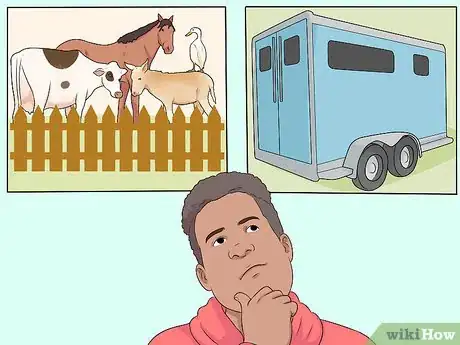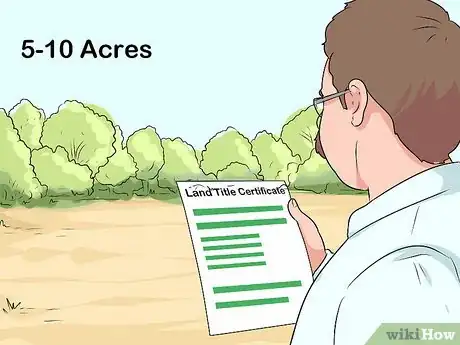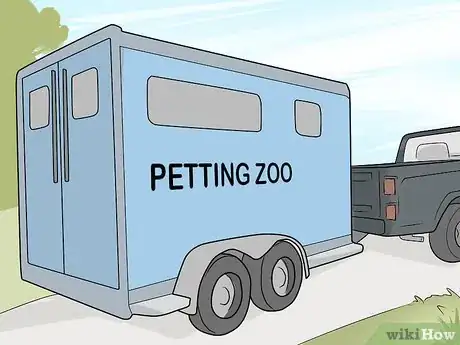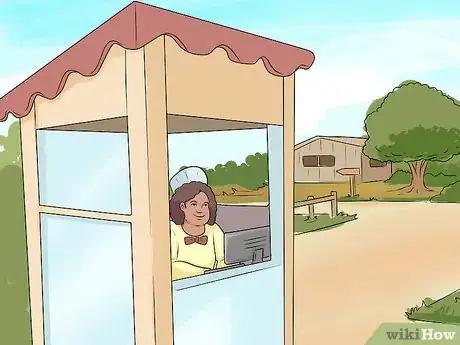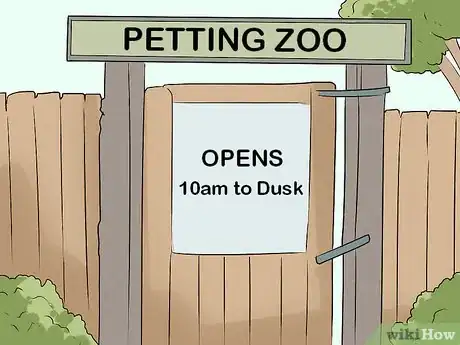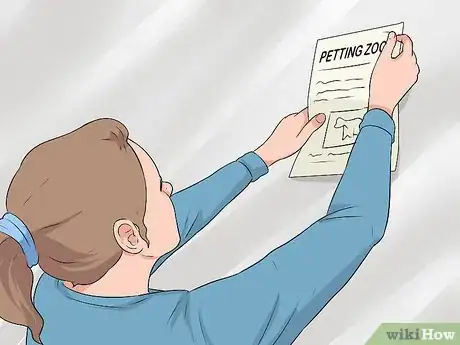This article was co-authored by wikiHow Staff. Our trained team of editors and researchers validate articles for accuracy and comprehensiveness. wikiHow's Content Management Team carefully monitors the work from our editorial staff to ensure that each article is backed by trusted research and meets our high quality standards.
wikiHow marks an article as reader-approved once it receives enough positive feedback. In this case, 86% of readers who voted found the article helpful, earning it our reader-approved status.
This article has been viewed 123,588 times.
Learn more...
Petting zoos are a fun and educational activity for people of all ages, but with the right planning, they can also be a lucrative business venture. If you're an animal lover who's always dreamed of operating your very own interactive sanctuary, your first step will be to apply for a license that permits you to legally own animals for display. Next will come leasing a plot of land spacious enough to suit your needs, then constructing the necessary facilities and leasing the animals themselves. After that, it will just be a matter of hiring help and finding resourceful ways to market your new business within your local community.
Steps
Getting Your Business off the Ground
-
1Decide what type of petting zoo you'd like to open. At regular petting zoos, visitors come to view and interact with animals within defined boundaries. However, there are also traveling varieties, where the animals are transported from place to place in order to reach people who otherwise wouldn't be able to see them.[1]
- A local petting zoo may be your option if your goal is to own and operate a business with regular hours and procedures.
- Traveling petting zoos often make stops at places like schools, daycares, retirement homes, community centers, and public events.[2]
-
2Apply for the appropriate business license. In order to operate a petting zoo legally, you'll first have to file the right paperwork. Most petting zoos in the United States require a Class C Exhibitor's license, which allows the proprietor to own animals for display purposes. Once you've been approved for your license, you can begin planning the next phases for getting your business off the ground.[3]
- You may need additional permits to work with exotic breeds.
- Review the farming and animal handling laws in your region to brush up on what sorts of practices are allowed
Advertisement -
3Buy, rent, or lease a suitable plot of land. Set aside enough space to meet your needs. It's recommend that you purchase 5-10 acres of open farmland to give your animals plenty of room to roam around. Make sure the property you choose is zoned for business or agricultural use according to local ordinances.[4]
- Is your petting zoo going to be a temporary endeavor or a full-time commitment? The answer to this question will help you determine whether it would be cheaper in the long run to buy or rent.
- Even if you're launching a traveling petting zoo, you'll still need a place to house your animals and serve as a base of operations between showings.
-
4Make sure you have the financial means. Sit down and make a list of your known expenses to get an idea of how much you'll have to put in each month. Running a petting zoo isn't cheap, especially if you plan on having more than a handful of animals to show off. You'll be paying for food, grooming supplies, veterinary services, and basic farming equipment on a regular basis, all on top of standard startup costs.[5]
- Consider taking out a business loan or seeking outside investors to supplement the capital you've already got.
- Keep in mind that you won't be making a profit right away, so you'll need to have enough money saved up to keep the business afloat through the early weeks and months.
Using Your Resources Effectively
-
1Develop your land. There will be lots to do to get your property ready to house free-roaming animals. Start with nitty-gritty tasks like leveling uneven terrain, clearing stray brush, draining ponds and marshes, and installing fences to mark your property line and keep the animals contained. From there, you can move on to landscaping and other aesthetic details to get the grounds looking just the way you want them.[6]
- Proceed with a simple, intuitive layout in mind. Configure your property in a long line and have visitors work their way from one end to the other, or situate the pens in a loop so they end up back where they started.
-
2Build the necessary facilities. While plotting the layout of your petting zoo, don't forget to take all your related spatial needs into consideration. At the very least, you'll need stalls and outdoor pens, a dedicated feeding area, restrooms, and one or two office buildings. Think up an intelligent way to arrange these facilities that allows both you and your visitors to get where you're going with ease.[7]
- If space permits, you could include other buildings like a separate storage room or gift shop.
- Once you're ready to break ground, hand off your plans to a team of specialty contractors to get construction underway.
-
3Add other unique touches for presentation. Now that the main structures are in place, think of any other elements you'd like to include to enhance the look of your property. You might have plaques made to provide a little information about each animal, or put up custom signposts to guide visitors in the right direction. The right atmosphere can make your petting zoo that much more inviting and memorable.[8]
- Place benches, picnic tables, or similar seating at regular intervals so tired visitors will have somewhere to sit and rest.
- Designate one or two especially scenic areas as backdrops where people can have their pictures made with the animals.
-
4Acquire an assortment of animals. No petting zoo is complete without the main attraction—the animals. Some of the most popular attractions at petting zoos include llamas, sheep, ponies, deer, and rabbits. To give your visitors a wide variety of species to interact with, be sure to lease lots of different animals, both big and small.[9]
- It's vital that you go through a reputable, licensed dealer when stocking your pens. In this case, you're looking for a Class A or Class B AWA license, which says that the vendor has permission to buy, sell, and trade live animals under federal law.[10]
- You'll have quite a bit of freedom when it comes to the types of animals you put on display, as long as they meet the conditions of your exhibitor's license and don't pose a threat to the safety of your customers or any of the other animals.
-
5Take your show on the road. For traveling petting zoos, some means of transporting your animals from place to place will be a must. Invest in an extra large trailer with partitions, good ventilation, and plenty of space for comfort. Have a few smaller mobile units on hand for moving larger animals like horses and, as well as groups of like species.[11]
- Decorate your convoy of vehicles with banners and decals bearing the name of the petting zoo to advertise while you're on the go to and from various events.
Operating Your Petting Zoo
-
1Hire employees to help manage the animals. Working with animals is a full-time responsibility, one that you won't be able to handle on your own. Adding a few other people to the payroll will ensure that the necessary feeding, cleaning, grooming, and administrative duties are taken care of while you focus on the challenges of ownership and operation. With a strong team, you can keep your animals healthy and contented and your business thriving.[12]
- Advertise jobs at your petting zoo to students, farm hands, and other individuals who are interested in working with animals on a part-time basis.
- In addition to hourly employees, you should hire at least one or two experienced animal handlers to see to the animals' daily needs.
-
2Decide how much you'll charge for admission. Entrance fees are how petting zoos make their money. With this in mind, come up with a price per head that you think is fair. It should be enough to generate the revenue you need to turn a profit, but not so high that it discourages people from coming in.[13]
- $8-10 for an adult is average, with a reduced rate of $5-7 for kids.
- Offering special discounts for small children and seniors may help to attract more business.
- For appearances at birthday parties and other events, charge a flat rate somewhere between $100-200 per hour.[14]
-
3Set your hours of operation. For the most part, petting zoos are thought of as daytime activities. You can start admitting your first visitors as early in the morning as you like and let them come and go until daylight fades. Most commercial petting zoos remain open from about 10am to dusk. If you have lit indoor holding pens, you'll have the option of staying open even later.
- Post your hours near the entrance of the zoo where they can be seen easily by those passing by. If you've launched a website for your business, be sure to list the information there, as well.
- Remember to update your hours to reflect holidays, special events, and necessary closures.
-
4Promote your business within the community. Get the word out about your new petting zoo by circulating mailer notices and posting ads at places where animal lovers tend to shop, such as pet stores and farming supply retailers. If you have enough funds remaining, you could even take out an ad in your local paper or secure a commercial slot on daytime television.[15]
- See if other small businesses in your area would be willing to help you advertise.
- Take advantage of the reach of social media by setting up a Facebook, Instagram, or even a Twitter account for your business.
Community Q&A
-
QuestionHow can I help homeless people by letting them live and work on zoos/farms?
 Community AnswerProvide accommodation on-site for them and research the necessary permits for this (similar to what you would need for flats or apartments). It may also be a good idea to get them to sign a contract specifying your requirements (e.g. taking the rent for accommodation out of their wages). You may also want to think about training them in a specific area and giving them a psychological evaluation, especially if they will be working closely with people and children.
Community AnswerProvide accommodation on-site for them and research the necessary permits for this (similar to what you would need for flats or apartments). It may also be a good idea to get them to sign a contract specifying your requirements (e.g. taking the rent for accommodation out of their wages). You may also want to think about training them in a specific area and giving them a psychological evaluation, especially if they will be working closely with people and children. -
QuestionHow can I start a small zoo in my garden?
 Community AnswerCheck your local area for what permits etc. you'd need to run a zoo in your back garden. You would also want to make sure it would be okay with your neighbors if you have any within about 2 acres of your property. Also, it may not be a good idea to own larger animals, so you would have to think about what kinds of animals you would be keeping. If you live in an area with lots of houses you might want to think about making yours stand out; painting the front with colorful animals is a great idea and it catches people's eyes.
Community AnswerCheck your local area for what permits etc. you'd need to run a zoo in your back garden. You would also want to make sure it would be okay with your neighbors if you have any within about 2 acres of your property. Also, it may not be a good idea to own larger animals, so you would have to think about what kinds of animals you would be keeping. If you live in an area with lots of houses you might want to think about making yours stand out; painting the front with colorful animals is a great idea and it catches people's eyes. -
QuestionCan I base it off other zoos?
 Community AnswerYes, this is actually a great idea. You can ask zoos which is their best attraction and then base your design off of that. For example, if one zoo does best with rabbits then base your zoo's rabbit enclosure off of theirs, and if another zoo does best with their horses then base you horse attractions off of theirs, etc. It may be a good idea to look at what shows people enjoy seeing the most so that you are not wasting money on shows that people don't want to see.
Community AnswerYes, this is actually a great idea. You can ask zoos which is their best attraction and then base your design off of that. For example, if one zoo does best with rabbits then base your zoo's rabbit enclosure off of theirs, and if another zoo does best with their horses then base you horse attractions off of theirs, etc. It may be a good idea to look at what shows people enjoy seeing the most so that you are not wasting money on shows that people don't want to see.
Warnings
- While you do have the option of operating your petting zoo part time, you should be aware that caring for the animals will be a round-the-clock job. That means you'll often find yourself working outside of your listed hours of operation.⧼thumbs_response⧽
- Be especially careful about keeping different species of animals separated while you're transporting or corralling them. The last thing you want is for them to become agitated and start attacking one another.⧼thumbs_response⧽
References
- ↑ https://www.entrepreneur.com/businessideas/petting-zoo
- ↑ https://www.atouchofbusiness.com/ideas/Petting-Zoo/Start-A-Petting-Zoo.html
- ↑ https://www.aphis.usda.gov/aphis/ourfocus/animalwelfare/SA_Regulated_Businesses
- ↑ http://www.hobbyfarms.com/why-to-think-twice-about-starting-a-farm-petting-zoo-7/
- ↑ https://howtostartanllc.com/business-ideas/petting-zoo
- ↑ https://howtostartanllc.com/business-ideas/petting-zoo
- ↑ http://www.hobbyfarms.com/why-to-think-twice-about-starting-a-farm-petting-zoo-7/
- ↑ http://www.hobbyfarms.com/why-to-think-twice-about-starting-a-farm-petting-zoo-7/
- ↑ https://www.atouchofbusiness.com/ideas/Petting-Zoo/Start-A-Petting-Zoo.html
- ↑ https://www.aphis.usda.gov/aphis/ourfocus/animalwelfare/SA_Regulated_Businesses
- ↑ https://www.atouchofbusiness.com/ideas/Petting-Zoo/Start-A-Petting-Zoo.html
- ↑ https://howtostartanllc.com/business-ideas/petting-zoo
- ↑ https://www.entrepreneur.com/article/238086
- ↑ https://howtostartanllc.com/business-ideas/petting-zoo
- ↑ https://howtostartanllc.com/business-ideas/petting-zoo
About This Article
Starting your own petting zoo is a great idea if you love animals and you have some business experience. First, you’ll need to figure out the cost of building and operating your zoo to make sure it’s financially viable. Costs will include building stalls, outdoors pens, a dedicated feeding area, restrooms, seating areas, and an office building or two. To run your petting zoo, you’ll need to regularly pay for food, grooming supplies, veterinary services, basic farming equipment, and staff wages. Once you’ve figured out your budget, apply for the license you need, which in the U.S. will usually be a Class C Exhibitor's license. Then, you can buy or rent a suitable plot of land, build your petting zoo, and bring the animals home. For more tips, including how to advertise your petting zoo, read on!
